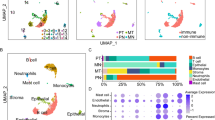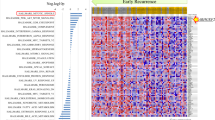Abstract
Background
In gastric cancer (GC), peritoneal dissemination (PD) occurs frequently and is incurable. In this study, we aimed to identify PD-associated genes in GC.
Methods
We identified a PD-associated gene using three GC datasets: highly disseminated peritoneal GC cell lines, the Singapore dataset and The Cancer Genome Atlas (TCGA) dataset. We assessed the clinicopathological significance of the gene expression using reverse transcription-quantitative polymerase chain reaction (RT-qPCR) and performed immunohistochemical analysis for the gene in our patient cohort. We also performed survival analyses of the gene in our patient cohort, the Singapore dataset and the GSE62254 datasets. Moreover, gene set enrichment analysis (GSEA) was performed using the Singapore and TCGA datasets. Finally, in vitro experiments such as invasion/migration assays, immunofluorescence staining of actin filaments, epidermal growth factor (EGF) treatment analysis, and gene expression analysis were conducted using three gene-knockdown GC cell lines (AGS, 58As9, MKN45).
Results
ADP-ribosylation factor-like 4c (ARL4C) was identified as a PD-associated gene, and immunohistochemical analysis showed that ARL4C was overexpressed in GC cells. High ARL4C expression was associated with the depth of invasion (p < 0.01) and PD (p < 0.05) and was a poor prognostic factor (p < 0.05) in our patient cohort, the Singapore dataset and the GSE62254 dataset. ARL4C expression positively correlated with the epithelial–mesenchymal transition (EMT) gene set in GSEA. Moreover, ARL4C knockdown reduced invasion/migration capacity, SLUG expression, and the formation of lamellipodia or filopodia in AGS and 58As9 cells. Finally, EGF treatment increased ARL4C expression in MKN45 cells.
Conclusions
ARL4C was associated with PD and was a poor prognostic factor in GC, possibly through promoting invasive capacity by activation of both EMT and motility.



Similar content being viewed by others
References
Jemal A, Bray F, Center MM, et al. Global cancer statistics. CA Cancer J Clin. 2011;61:69–90.
Thomassen I, van Gestel YR, van Ramshorst B, et al. Peritoneal carcinomatosis of gastric origin: a population-based study on incidence, survival and risk factor. Int J Cancer. 2014;134:622–8.
Bando E, Yonemura Y, Takeshita Y, et al. Intraoperative lavage for cytological examination in 1297 patients with gastric carcinoma. Am J Surg. 1999;178:256–62.
Nie RC, Chen S, Yuan SQ, et al. Significant role of palliative gastrectomy in selective gastric cancer patients with peritoneal dissemination: a propensity score matching analysis. Ann Surg Oncol. 2016;23(12):3956–63.
Bernards N, Greemers GJ, Nieuwenhuijzen GA, et al. No improvement in median survival for patients with metastatic gastric cancer despite increased use of chemotherapy. Ann Oncol. 2013;24:3056–60.
Yang XJ, Huang CQ, Suo T, et al. Cytoreductive surgery and hyperthermic intraperitoneal chemotherapy improves survival of patients with peritoneal carcinomatosis from gastric cancer: final results of a phase III randomized clinical trial. Ann Surg Oncol. 2011;18:1575–81.
Tomczak K, Czerwinska P, Wiznerowicz M. The cancer genome atlas (TCGA): an immeasurable source of knowledge. Contemp Oncol (Pozn). 2015;19;68–77.
Dhanasekaran SM, Balbin OA, Chen G, et al. Transcriptome meta-analysis of lung cancer reveals recurrent aberrations in NRG1 and Hippo pathway genes. Nat Commun. 2014;5:5893
Collisson EA, Campbell JD, Brooks AN, et al. Comprehensive molecular profiling of lung adenocarcinoma. Nature. 2014;511:543–50.
Mir SE, Hamer PCDW, Krawczyk PM, et al. In silico analysis of kinase expression identifies WEE1 as a gatekeeper against mitotic catastrophe in glioblastoma. Cancer Cell. 2010;18;244–57.
Kurashige J, Hasegawa T, Niida A, et al. Integrated molecular profiling of human gastric cancer identifies DDR2 as a potential regulator of peritoneal dissemination. Sci Rep. 2016;6:22371.
Yanagihara K, Takigahira M, Tanaka H, et al. Development and biological analysis of peritoneal metastasis mouse models for human scirrhous stomach cancer. Cancer Sci. 2005;96:323–32.
Yanagihara K, Takigahira M, Takeshita F, et al. A photon counting technique for quantitatively evaluating progression of peritoneal tumor dissemination. Cancer Res. 2006;66:7532–9.
Fujii S, Matsumoto S, Nojima S, et al. Arl4c expression in colorectal and lung cancers promotes tumorigenesis and may represent a novel therapeutic target. Oncogene. 2014;34:4834–44.
Mizuno H, Kitada K, Nakai K, et al. PrognoScan: a new dataset for meta-analysis of the prognostic value of genes. BMC Med Genomics. 2009;2:18.
Kolch W, Halasz M, Granovskaya M, et al. The dynamic control of signal transduction networks in cancer cells. Nat Rev Cancer. 2015;15:515–27.
Fidler IJ. The pathegenesis of cancer metastasis: the ‘seed and soil’ hypothesis revisited. Nat Rev Cancer. 2003;3:453–8.
Miyake S, Kitajima Y, Nakamura J, et al. HIF-1α is a crucial factor in the development of peritoneal dissemination via natural metastatic routes in scirrhous gastric cancer. Int J Oncol. 2013;43:1431–40.
Machesky, LM. Lamellipodia and filopodia in metastasis and invasion. FEBS Lett. 2008;582.14:2102–111.
Yilmaz M, Christofori G. EMT, the cytoskeleton, and cancer cell invasion. Cancer Metastasis Rev. 2009;28:15–33.
Matsumoto S, Fujii S, Sato A, et al. A combination of Wnt and growth factor signaling induces Arl4c expression to form epithelial tubular structures. EMBO J. 2014;33:702–18.
Hynes NE, Lane HA. ERBB receptors and cancer: the complexity of targeted inhibitors. Nat Rev Cancer. 2005;5:341–54.
Birkman EM, Alqars A, Lintunen M, et al. EGFR gene amplification is relatively common and associates with outcome in intestinal adenocarcinoma of the stomach, gastro-oesophageal junction and distal oesophagus. BMC Cancer. 2016;16:406.
Burd CG, Strochlic TI, Setty SRG. Arf-like GTPases: not so Arf-like after all. Trends Cell Biol. 2004;14:687–94.
Pasqualato S, Renault L, Cherfils J. Arf, Arl, Arp and Sar proteins: a family of GTP‐binding proteins with a structural device for ‘front–back’ communication. EMBO Rep. 2002;3:1035–41.
Hofmann I, Thompson A, Sanderson CM, et al. The Arl4 family of small G proteins can recruit the cytohesin Arf6 exchange factors to the plasma membrane. Curr Biol. 2007;17:711–6.
Huang J, Xiao D, Li G, et al. EphA2 promotes epithelial–mesenchymal transition through the Wnt/β-catenin pathway in gastric cancer cells. Oncogene. 2014;33:2737–47.
Zhang Y, Du J, Zheng J, et al. EGF-reduced Wnt5a transcription induces epithelial–mesenchymal transition via Arf6-ERK signaling in gastric cancer cells. Oncotarget. 2015;6:7244–61.
Acknowledgements
The authors would like to thank K. Oda, K. Kasagi, S. Sakuma, M. Oshiumi, and M. Utou for their technical assistance, Dr. T. Sato for statistical analysis, and Dr. Tyler Lahusen for English proofreading.
Funding
This work was supported in part by the following Grants and foundation: Japan Society for the Promotion of Science Grant-in-Aid for Scientific Research (Grant Nos.: 16K07177, 16K10543, 16K10397, 16K19197, 16K19107, 16H01576, 26461980, 26293303).
Disclosures
Qingjiang Hu, Takaaki Masuda, Kuniaki Sato, Taro Tobo, Sho Nambara, Shinya Kidogami, Naoki Hayashi, Yosuke Kuroda, Shuhei Ito, Hidetoshi Eguchi, Hiroshi Saeki, Eiji Oki, Yoshihiko Maehara, and Koshi Mimori have no potential conflicts of interest to declare.
Author information
Authors and Affiliations
Corresponding author
Electronic Supplementary material
Below is the link to the electronic supplementary material.
Rights and permissions
About this article
Cite this article
Hu, Q., Masuda, T., Sato, K. et al. Identification of ARL4C as a Peritoneal Dissemination-Associated Gene and Its Clinical Significance in Gastric Cancer. Ann Surg Oncol 25, 745–753 (2018). https://doi.org/10.1245/s10434-017-6292-6
Received:
Published:
Issue Date:
DOI: https://doi.org/10.1245/s10434-017-6292-6




